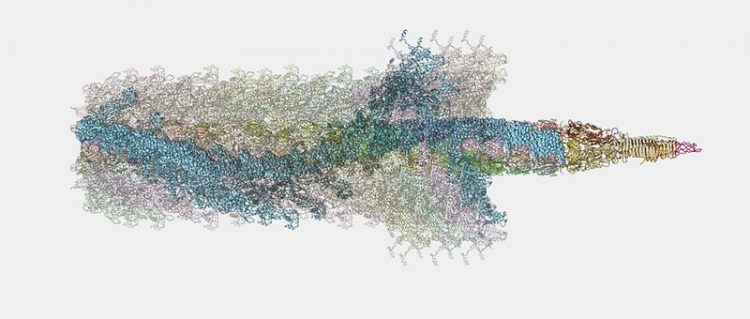Bacterial Nanosized Speargun Works Like a Power Drill

Structure of the bacterial nanosized speargun – called type VI secretion system – during contraction. University of Basel, Biozentrum
Millions of tiny microbes on leaves, stones or our skin jostle for space. And almost everywhere they have to compete for resources and nutrients. In the course of evolution, some bacteria have therefore developed a weapon to inject a toxic cocktail into competitors and rivals in their neighborhood, thus eliminating them. Among experts, this weapon resembling a speargun is also known as the type VI secretion system (T6SS).
Two years ago, Prof. Marek Basler was able to elucidate the atomic structure of the speargun in the “post-firing” state. In the current study, which was carried out in cooperation with various research groups and technology platforms at the Biozentrum, his team has now solved the structure of the “ready to fire” speargun. Based on these findings, the researchers have been able to model how this T6SS speargun works.
Structure of nanosized speargun changes during firing
The speargun is composed of various components, including a sheath and a spear with a sharp tip. The sheath consists of over 200 connected cogwheel-like protein rings that are assembled around the inner rigid spear. When T6SS fires, the sheath rapidly contracts and pushes the toxic spear out of the cell, which can then penetrate into neighboring cells where it releases deadly toxins. “So far, there have only been assumptions as to how the structure of the T6SS sheath changes during contraction,” says Basler. “Using cryo-electron microscopy available at C-CINA, we have now obtained an image of the spear and the extended sheath in atomic resolution.”
By comparing the structures of the extended and contracted states, the researchers were able to model how the T6SS works in detail. “During the sheath contraction, ring after ring turns and gets closer to the previous ring, while the ring diameter expands and thus releases the spear,” explains Basler. “This combination of sheath shrinking and turning results in drilling a hole into the target cells. Within less than two milliseconds, the T6SS sheath contracts to half of its length and at the same time the toxic spear spirals out like a screw. Therefore, the bacteria have an extremely powerful drill.”
Only contracted T6SS sheaths are disassembled
Furthermore, the researchers also addressed another question. After firing T6SS, bacteria re-use the individual components of the sheath to assemble a new speargun. “For a long time, it was not clear why only the contracted, but not the extended sheath is disassembled,” says Basler. “Now, we could see that a certain protein domain is exposed on the surface of the sheath during contraction and can be recognized by a specific protein responsible for dismantling the sheath. In the extended sheath state, this domain is hidden and the T6SS sheath is therefore protected from disassembly.”
The bacterial speargun will continue to be the subject of future research. “One of our projects is dedicated to the question of how the T6SS is embedded in the bacterial cell envelope. As the speargun is fired with such a high force, it must be firmly anchored, otherwise firing would not work properly or could be also fatal for the weapon-carrying bacteria themselves.”
Original article
Jing Wang, Maximilian Brackmann, Daniel Castaño-Díez, Mikhail Kudryashev, Kenneth N. Goldie, Timm Maier, Henning Stahlberg and Marek Basler
Cryo-EM structure of the extended type VI secretion system sheath-tube complex
Nature Microbiology (2017), doi: 10.1038/s41564-017-0020-7
Video: Prof. Marek Basler, Bacterial nanosized speargun
https://www.youtube.com/watch?v=wrGOU76fg40
Further information
Prof. Dr. Marek Basler, University of Basel, Biozentrum, Tel. +41 61 207 21 10, email: marek.basler@unibas.ch
Dr. Katrin Bühler, University of Basel, Biozentrum, Communications, Tel. +41 61 207 09 74, email: katrin.buehler@unibas.ch
Media Contact
More Information:
http://www.unibas.chAll latest news from the category: Life Sciences and Chemistry
Articles and reports from the Life Sciences and chemistry area deal with applied and basic research into modern biology, chemistry and human medicine.
Valuable information can be found on a range of life sciences fields including bacteriology, biochemistry, bionics, bioinformatics, biophysics, biotechnology, genetics, geobotany, human biology, marine biology, microbiology, molecular biology, cellular biology, zoology, bioinorganic chemistry, microchemistry and environmental chemistry.
Newest articles

A ‘language’ for ML models to predict nanopore properties
A large number of 2D materials like graphene can have nanopores – small holes formed by missing atoms through which foreign substances can pass. The properties of these nanopores dictate many…

Clinically validated, wearable ultrasound patch
… for continuous blood pressure monitoring. A team of researchers at the University of California San Diego has developed a new and improved wearable ultrasound patch for continuous and noninvasive…

A new puzzle piece for string theory research
Dr. Ksenia Fedosova from the Cluster of Excellence Mathematics Münster, along with an international research team, has proven a conjecture in string theory that physicists had proposed regarding certain equations….



